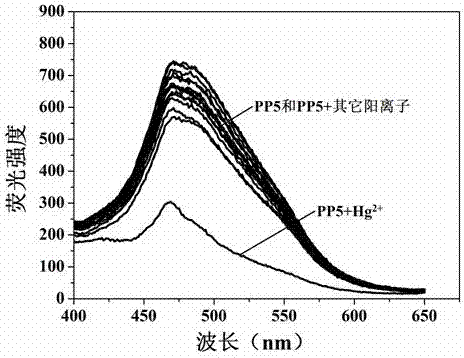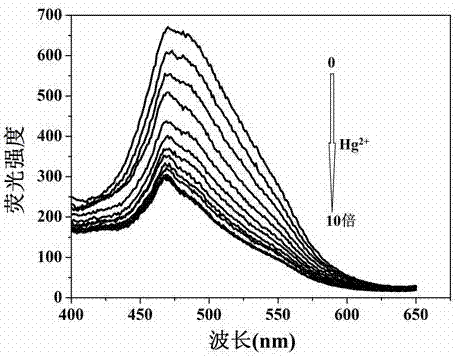Pillar 5 arene polymer, synthesis and application thereof in fluorescence detection and mercury ion removal
A technology of high polymers and aromatics, applied in the direction of fluorescence/phosphorescence, luminescent materials, chemical instruments and methods, etc., can solve problems such as inability to separate mercury ions
- Summary
- Abstract
- Description
- Claims
- Application Information
AI Technical Summary
Problems solved by technology
Method used
Image
Examples
Embodiment 1
[0037] Embodiment 1, the synthesis of pillar 5 aromatic hydrocarbon high polymer
[0038] (1) Synthesis of Copolymerized Pillar 5 Aromatics
[0039] Synthesis of Intermediate 1: Hydroquinone (2.2 g, 20.0 mmol), K 2 CO 3 (13.8 g, 100 mmol), KI (0.83 g, 5 mmol), PEG-400 (4 mL, 10 mmol), 1,4-dibromobutane (17.28 g, 80 mmol) and acetone (300~400 mL) were added to a 500 mL round bottom In the flask, stirred and reacted at 60°C for 36 h, cooled to room temperature, removed the inorganic salt by suction filtration, evaporated the solvent under reduced pressure, and separated by column chromatography to obtain a white solid which is intermediate compound 1 with a yield of 80%. m.p: 83~85 ° C; 1 H NMR (400MHz, CDCl 3 ) δ (ppm): δ 6.81 (s, 4H), 3.94 (dd, J = 10.0, 5.8 Hz, 4H), 3.48(t, J = 6.6 Hz, 2H), 3.26 (t, J = 6.8 Hz, 2H), 2.09-1.85 (m, 8H).
[0040] Synthesis of Copolymer 5 Aromatics 2: Add 1,2-dichloroethane (300 mL) into a 500 mL round low flask, add intermediate c...
Embodiment 2
[0049] Embodiment 2, identify Hg with PP5 2+
[0050] Dimethyl sulfoxide turbid solution in PP5 (water content 50%, PP5 concentration 4×10 -4 mol L -1 ), adding Mg 2+ , Ca 2+ , Zn 2+ , Co 2+ , Fe 3+ , Pb 2+ , Cd 2+ , Hg 2+ , Ni 2+ , Tb 3+ , Cu 2+ , Eu 3+ , Fe 2+ , Cr 3+ , Ag + , La 3+ DMSO solution (0.004 mol L -1 ), if the fluorescence of PP5 turbid solution is quenched, it means that Hg was added 2+ , if the fluorescence of the PP5 turbid solution does not change, it means that the addition of Hg is not 2+ .
Embodiment 3
[0051] Embodiment 3, remove the Hg in the aqueous solution with PP5 2+
[0052] Add 5 mg of PP5 polymer to 5 mL of Hg 2+ aqueous solution (1 x 10 -4 mol L −1 ), stirred at room temperature for 5 hours, filtered to remove insoluble matter, and detected the clear aqueous solution by ICP method, and found that Hg 2+ is almost eliminated (for Hg 2+ The removal rate is 96.25%).
PUM
 Login to View More
Login to View More Abstract
Description
Claims
Application Information
 Login to View More
Login to View More - R&D
- Intellectual Property
- Life Sciences
- Materials
- Tech Scout
- Unparalleled Data Quality
- Higher Quality Content
- 60% Fewer Hallucinations
Browse by: Latest US Patents, China's latest patents, Technical Efficacy Thesaurus, Application Domain, Technology Topic, Popular Technical Reports.
© 2025 PatSnap. All rights reserved.Legal|Privacy policy|Modern Slavery Act Transparency Statement|Sitemap|About US| Contact US: help@patsnap.com



